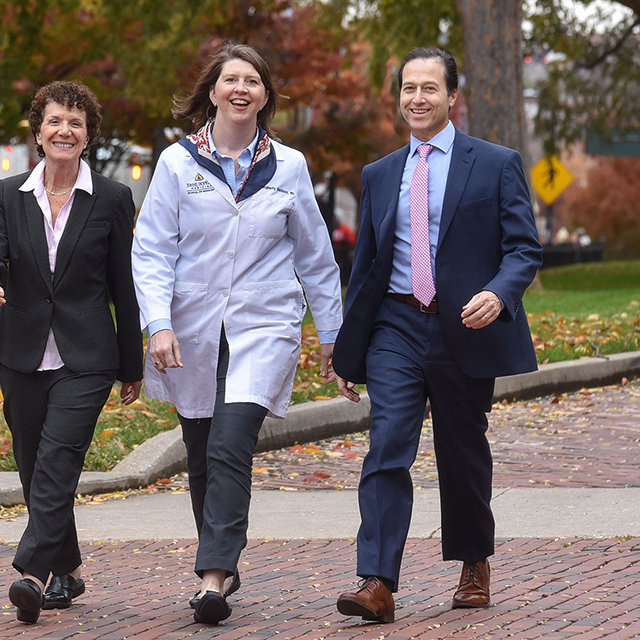Johns Hopkins Medicine launched the Office of Well-Being in late 2018 with an ambitious goal: To sweep away the unnecessary stresses that stand in the way of employee job fulfillment and health.
"We have amazing people who work here, and it is our job to figure out how to make their work lives better,” says Lee Daugherty Biddison, who leads the office as chief wellness officer.
Biddison’s focus is on reducing workplace inefficiencies and improving work-life balance for doctors, while Deborah Dang, chief nursing director for well-being, aims her initiatives at helping nurses build trust within teams, reduce workplace hassles, and improve well-being.
Richard Safeer, chief medical director of employee health and well-being, works to support the health of all JHM employees.
Their initiatives often overlap. For example, a new software platform, QGenda, simplifies on-call scheduling for doctors, but also helps the rest of the clinical team keep track of which doctors are available. Other initiatives include Zen rooms where clinicians can unwind, a music room with a grand piano for faculty and staff to use, and employee blood pressure screenings.
Safeer has been helping Johns Hopkins Medicine employees make healthy choices since he was hired in 2012; a key accomplishment was bringing more nutritious food and drink choices to Hopkins campuses.
“Being healthy is not necessarily a program or an app,” he says. “It’s the sum of multiple choices throughout the day. Since our employees spend most of their waking hours in the workplace, it’s important that we make it easy for them to make healthy choices. “
More recently, Safeer oversaw the February launch of an improved Healthy at Hopkins employee portal that provides better mobile and social experiences while continuing to provide health information and ways to track healthful behaviors such as exercising or getting enough sleep.
Through the portal, about 400 people have signed on as “champions” to bring health information and activities such as lunchtime walks to their departments. Of those, about 100 are nurses, says Dang, who hopes to tap that energy to engage nurses in using evidence-based self-care practice throughout their day.
“Nationally, nurses are less healthy than the average American,” she says. “We want to make sure they also take care of themselves as well as others. When nurses are kind to themselves, they better serve patients and have stronger relationships with colleagues.”
Some Office of Well-Being initiatives:
QGenda: When doctors need to change their on-call schedules, they can use the QGenda system to see who is available and update schedules in real time. The scheduling software replaces a patchwork of existing systems and a “hallway handshake” method that involves asking around to see who can fill in, and then distributing printed calendars with updated information. “It was frustrating for schedulers and nurses who were trying to figure out who was on call,” Biddison says. QGenda, now used in the radiology, cardiology and gastroenterology departments, among others, will roll out across the Johns Hopkins University School of Medicine and health system between now and 2023.
Zen and Meditation Rooms: When Nelson 5 nurses wanted a place to escape the hustle and bustle of the 21-bed intermediate care unit, they raised money and tapped the design skills of fellow Nelson 5 nurse Kelly Wilkinson. She painted and decorated an unused consulting room, turning it into a Zen retreat complete with yoga mats and a massage chair. The space, which opened in October 2019, can be used by any member of the unit’s staff, says nurse manager Lara Street. “People love it,” she says.
All Johns Hopkins Medicine hospitals have some form of meditation or quiet rooms, says Safeer. Dang is planning a study to evaluate the well-being benefits of such spaces.
Blood Pressure Screenings: In 2019, the Office of Well-Being offered blood pressure screening to all employees, says Safeer. Of the 7,300 employees who participated, 60 percent tested for elevated or high blood pressure, and half of those did not know their high blood pressure was abnormal, Safeer says.
Sprint: This program brings Epic experts to individual hospital clinics for two weeks of focused training for the entire team. “They spend time one on one with every person in the clinic,” says Biddison. “They see how individuals work and offer tools and ideas for improving efficiency. People are getting relevant training in the production environment, with approaches tailored to their individual needs.” The program, modeled after one at the University in Colorado, will be piloted this year in general internal medicine and dermatology clinics at Green Spring Station.
Building High-Trust Work Environments: The Johns Hopkins Hospital created the Center for the Practice of Collaborative Leadership in 2017 to study how its clinical teams build trust. With support from the center, every clinical department now has at least two certified trust leaders who teach, model and facilitate trust-building behaviors such as recognizing peers’ strengths and considering how words and actions affect others, says Dang. Plans are underway to assess nurse leaders’ interest in expanding trust-building work across the health system.
New Healthy at Hopkins Portal: The new employee health and well-being portal includes an app that can synchronize with wearable devices such as step-trackers or heart monitors, says Safeer. Also new: Users can create social groups around interests such as yoga or low-sodium cooking and include as many as five non-Hopkins individuals.
Dragon Medical One: The medical transcription software was one of the first initiatives announced by the office, and now has about 1,500 consistent users, says Biddison. Clinicians say the voice recognition tool seamlessly transcribes in Epic in real time, creating a work day that is more efficient and focused on patients. “It’s having an important impact, and we’re looking forward to expanding it,” says Biddison.


